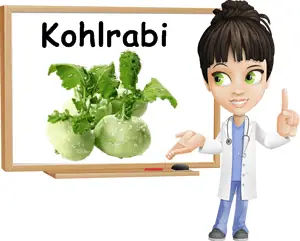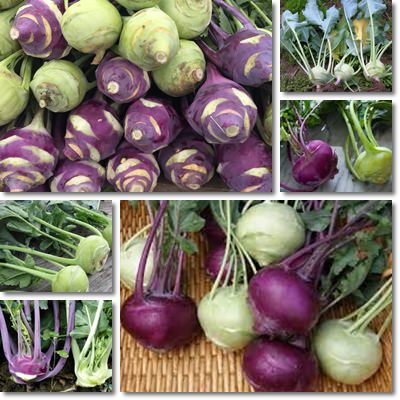Related to cabbage, cauliflower, broccoli, collards, kale and Brussels sprouts, kohlrabi (Brassica oleracea Gongylodes) is a preferred vegetable in many European countries. Its low energetic value, high dietary fiber content and good nutrient profile make it a healthy addition to any diet. Kohlrabi is a good source of important nutrients, namely vitamin C, B vitamins, copper, phosphorus, manganese and potassium.
Kohlrabi contains glucosinolates, natural compounds in cruciferous vegetables shown to possess anticancer properties in in vitro and in vivo studies. Kohlrabi has also been shown to exhibit antidiabetic and cardiovascular protective properties. Although it doesn’t have the most memorable taste, it is quite palatable and can be employed in a variety of dishes, both fresh and cooked. However, cooking the vegetable will cause it to lose most or all of its vitamin C content due to the fact that the nutrient is highly sensitive to cooking heat.

What is kohlrabi?
Kohlrabi is also known as German turnip or German cabbage as well as turnip cabbage. All three alternative names hint at the vegetable’s kinship with cabbage and at its turnip-like appearance. In some circles it is considered a variety of cabbage, despite its peculiar, more turnip-like appearance. Kohlrabi is actually a stem vegetable, meaning its edible bulb is actually a bulky, swollen stem.
What does kohlrabi look like?
Although used as a root vegetable, kohlrabi is actually a stem vegetable, meaning that the bulbous bottom has developed from a stem. Kohlrabi is a turnip look-alike with fibrous roots, a soft and fibrous pale green or purple skin and creamy white, crisp, succulent flesh. Thin, long, pale green or purple stems with large leaves are attached to the bulky bulb. When removed, they leave cut-like impressions on the bulb.
If you ask me, kohlrabi looks like an alien egg sprouting tentacles. Depending on the the maturity of the vegetable and on the cultivar, it may be small enough to fit in the palm of your hand, or large enough to have to be held in both hands, well surpassing 10 cm in diameter. Stems may also grow as long as 50 cm.
What does kohlrabi taste like?
Kohlrabi skin has a fibrous texture and a taste similar to broccoli stems. Because it tends to stay fibrous even after cooking, many people discard it before cooking or eating the vegetable. The creamy white flesh has a crisp texture and a barely noticeable sweet, slightly peppery taste, far less intense than that of cabbage heart. The sweet-peppery flavor is characteristic of cruciferous vegetables. If left to mature, the vegetable becomes woody. Cooked kohlrabi takes on a soft texture and sweeter flavor. Kohlrabi stems and roots are both edible. The stems can be eaten raw, in salads, or cooked similar to mustard greens, kale or collard greens.

What are the benefits of kohlrabi?
Despite its odd appearance, kohlrabi is quite a nutritious and appetizing vegetable. Here are 7 great nutrition facts and health benefits of kohlrabi you should know about.
Anticancer properties
Similar to other cruciferous vegetables like cabbage or broccoli, kohlrabi has been found to contain glucosinolates, natural compounds with anticancer effects. Glucosinolates are sulfur compounds which give certain vegetables their distinct, pungent odour or peppery flavor. Specific enzymatic reactions lead to the formation of biologically active compounds known as isothiocyanates and indoles. Isothiocyanates can help combat cancer by inducing apoptosis (programmed cell death) in certain cancer cells, as well as by preventing cell mutations that may lead to cancer.
According to research conducted at the Oregon State University, eating cruciferous vegetables on a regular basis can help lower cancer risks, notably mouth and lung cancers (Epidemiological studies on brassica vegetables and cancer risk. Cancer Epidemiol Biomarkers Prev. 1996). Numerous other studies suggest that cruciferous vegetables consumption, kohlrabi included, can reduce the risk of developing several cancers such as colon, lung, mouth or hormone-sensitive cancers.
Natural antidiabetic properties
According to the National Institute for Biotechnological Information, kohlrabi exhibits antidiabetic and anti-inflammatory properties as a result of its high polyphenols, glucosinolates and isothiocyanates content. When compared, purple kohlrabi was shown to possess stronger antidiabetic effects than green kohlrabi (Anti-Diabetic and Anti-Inflammatory Effects of Green and Red Kohlrabi Cultivars (Brassica oleracea var. gongylodes). Water extracts of the vegetable have also been shown to lower blood sugar levels in diabetics, contributing to diabetes management and prevention.
Rich source of antioxidants
Kohlrabi has been shown to contain glucosinolates (isothiocyanates in particular), anthocyanins and carotenoids, among other polyphenols. These natural compounds possess great antioxidant value and help protect cells from free radical damage that can cause them to mutate into cancerous formations.
Good source of dietary fiber
With 3.6 g of dietary fiber/ 100 g of raw flesh, kohlrabi helps reduce the absorption of fats at the intestinal levels and thus indirectly contributes to lowering LDL (bad) cholesterol and triglycerides level as well as support a healthy weight loss process. By regulating digestion and reducing intestinal transit time, the vegetable helps relieve constipation naturally and protect colon health.
Generous source of vitamin C
Kohlrabi is a good source of vitamin C, providing 62 mg of the nutrient for every 100 g of raw flesh. Vitamin C not only acts as an antioxidant, protecting cells and DNA against free radical damage, but also boosts immunity and reduces inflammation markers in the body, contributing to a lower risk of chronic diseases. However, cooking kohlrabi will cause it to lose most or all of its vitamin C content, depending on the amount of time the vegetable is exposed to cooking heat. Eating it raw is recommended.
Good source of several dietary nutrients
B vitamins, copper, magnesium, phosphorus and potassium are all found in kohlrabi. Copper, for example, helps prevent premature aging signs such as hair graying or eye discoloration, whilst magnesium and potassium contribute to cardiovascular health. Phosphorus helps keep bones strong, while manganese exhibits a strong antioxidant action.
Good for cardiovascular health
The good amounts of vitamin C in kohlrabi contribute to keeping blood vessels clean of plaque and flexible, thus reducing atherosclerosis and stroke risks. Moreover, potassium and magnesium help regulate blood pressure, heart rate and support the function of the muscle heart.
Conclusion
Kohlrabi, the German staple known as German turnip or turnip cabbage, is enjoying growing popularity not only because of its nutritional value, but also as a result of its almost medicinal properties. Both cooked and raw kohlrabi should offer great health benefits and provide us with a great taste experience, on the condition they are a regular part of our diet.
